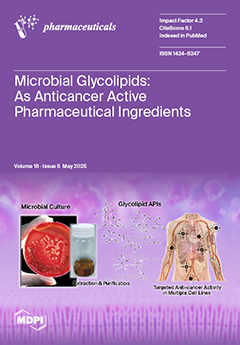Background/Objectives: Breast cancer continues to be a major global health challenge, driving the urgent need for innovative therapeutic strategies. This study evaluates the anticancer and immunomodulatory potential of skimmianine in breast cancer through a comprehensive approach, integrating biochemical, histopathological, immunohistochemical, and bioinformatics analyses.
Methods: Thirty-six female Wistar albino rats were divided into three groups: control, 7,12-dimethylbenz[a]anthracene (DMBA)-induced breast cancer, and DMBA + skimmianine (
n = 12/group). Breast cancer was induced with a single oral dose of 50 mg/kg DMBA in sesame oil. After 16 weeks, skimmianine (40 mg/kg) was administered intraperitoneally for four weeks. Serum CA15-3 levels were measured via enzyme-linked immunosorbent assay (ELISA). Histopathological assessment was performed using hematoxylin and eosin (H&E) staining, and proliferating cell nuclear antigen (PCNA) and tumor necrosis factor-alpha (TNF-α) were evaluated immunohistochemically. Pathway and hub gene analyses were performed using Cytoscape, functional annotation with Enrichr, and immune analyses via the Tumor and Immune System Interaction Database (TISIDB) and Sangerbox.
Results: The tumor burden in the animals increased after DMBA induction compared to the control groups (0.00 ± 0.00% vs. 89.00 ± 6.60%, respectively,
p < 0.001), while skimmianine treatment significantly reduced the tumor burden in the animals (49.00 ± 9.40%, vs. DMBA group,
p = 0.191). Histopathological analysis showed DMBA-induced structural disorganization and malignant clustering, whereas skimmianine preserved ductal structures and mitigated the damage. Compared to the control group, DMBA administration markedly elevated serum CA15-3 levels (0.23 ± 0.06 ng/mL vs. 8.57 ± 1.01 ng/mL, respectively), along with PCNA (13.0 ± 3.0% vs. 25.0 ± 4.0%, respectively) and TNF-α (8.4 ± 1.7% vs. 34.0 ± 5.3%, respectively) expression, indicating active tumor progression. Skimmianine treatment significantly reduced CA15-3 (3.72 ± 0.58 ng/mL), PCNA (20.0 ± 4.1%), and TNF-α (25.0 ± 3.9%) levels (
p < 0.001). In silico analyses indicated skimmianine’s effects on PCNA influence cell cycle pathways, while TNF-α suppression impacts toll-like receptor (TLR) signaling (adjusted
p < 0.05). PCNA- and TNF-α-related anticancer effects were especially notable in basal molecular and C2 immune subtypes (
p < 0.05). Related hub proteins may regulate immune dynamics by reducing immunosuppression and tumor-promoting inflammation (
p < 0.05).
Conclusions: Skimmianine shows promise as a breast cancer therapy by simultaneously targeting tumor growth and immune regulation, with PCNA and TNF-α identified as potential key players.
Full article






